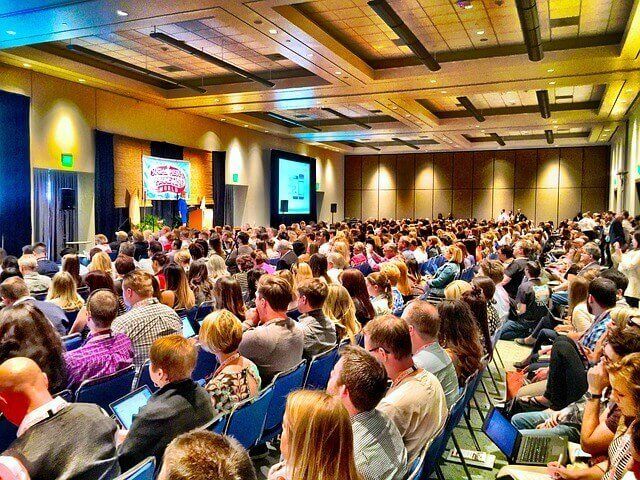
As life returns to semi-normal (at least compared with peak lockdown during Covid-19), it’s been especially refreshing to see a return to in-person events.
It’s also fantastic that there’s now the increasingly common hybrid option to attend virtually through live streaming.
The pandemic popularized virtual meet-ups largely out of necessity, but it’s nice to know that virtual attendance isn’t going anywhere anytime soon; this opens the doors for the immunocompromised, the disabled, and anyone who wishes to bypass face-to-face interactions for whatever reason.
It also provides an option for marketers who may not have a travel budget to attend in-person events.
While event marketers have faced their fair share of pivots between early 2020 and today, it seems the large majority have a solid handle on the landscape now.
I’ve got so much respect for them – of the many roles I have had in my B2B marketing career; event marketing was one of the hardest. (And that was without a pandemic to factor in.)
It’s not so much that event marketing is hard, but rather that it requires enormous attention to a large number of details.
Advanced planning is a must. Here’s a blog post I wrote about managing a large-scale tech event.
Some of you reading this may have had the experience of running roadshows or events in 15-20 cities across the country, but have you ever had to extend those events internationally? It’s a whole different ball game.
Let’s face it – headaches are inevitable in this line of work, but minimizing difficulties is our main goal.
Read on to discover 5 key guidelines I’ve personally used to ensure events are relatively easy to scale across regions.
Whether you’re planning an event that’s in-person, virtual or a hybrid of the two, I hope you’ll find these tips as useful as I have over the years.
Hold regular checkpoint meetings
A kickoff meeting with the geography teams and agencies is an absolute must. This is your opportunity to communicate event objectives, audience targets, success metrics, rollout timeline, and budget.
Seek feedback and incorporate it into your plan moving forward, and create agreed-upon deliverables and timelines.
Depending on the size of the event, as well as projected prep time and the time available for promotion, I’d recommend starting the event planning process at least 3-6 months in advance, especially if you know that you will need headquarters and regional collaboration.
(Sometimes you don’t have the luxury of 3-6 months to plan an event, you do the best you can with the time you have. That’s how we roll.)
Plan to carve out a window of time on a weekly or biweekly basis (scale it up or down depending on necessity and availability) to discuss progress and address any outstanding issues. You should also mentally prepare yourself for early morning and/or late night calls; time zone differences are often a logistical factor requiring compromise and sacrifice.
“Over-communication is better than under-communication.”
Obtain a local agency and program manager
I’ve done out-of-country events with and without an agency or a program manager on the ground. Let me tell you; it’s incredibly difficult to manage events remotely, especially when they’re happening in a different country. If you find that you have no choice but to manage an event from afar in the lead-up to go time, I’d recommend that you spend at least 1-3 weeks on the ground prior to the event kickoff to align with the team. Don’t skin on the travel budget.
While the hire of a local agency, program manager, or affiliate is inevitably pricey, don’t shy away from the expense; a bit of sticker shock and a bite out of your budget is nothing compared to the ramifications of a poorly executed event. I cannot stress this enough.
“It’s a trade-off you have to make between money and time.”
Trust me, it’s worth it.
Prepare a kit with standardized event elements
If you are in the headquarters, please make an effort to standardize anything and everything you can think of. Consolidate the resulting standardized event elements into a kit. Some examples of standardized content include:
- Event objectives
- Proposed event agenda (keynote and training)
- Style guide (creative for booths, stage back-drop, lanyards, logo, banners, etc.)
- Training content (and possibly recruitment of speakers)
- Information to be displayed on devices and flat panels throughout the venue
- Event themes, messaging and positioning for the events
- Websites in different languages
- Social media conversation guidance
- Sponsorship packages (but allow local geographies to customize if they are local sponsors)
“Standardization does not mean that localization or customization is not allowed. Localize and customize when it makes sense to reflect the true essence of your events.”
Why is standardization so important? Ben Hindman writes for Forbes that “building compelling branded event marketing templates, including promotional materials and invitations, that can be used for more than one event and by more than one team…enables scale across teams and the organization, alleviating the pressure felt from fewer resources. It also helps ensure brand consistency and eye-catching marketing materials across all events — in-person, virtual and hybrid.”
Discuss the appropriate kit content with your local contacts. Ultimately, the objective of the event kit is to make the geographies’ jobs as easy and streamlined as possible.
Decide on a decentralized vs. centralized registration system
This is tough. Personally, I believe in a centralized registration system, and all leads being stored in one database. The reason is simple – event attendees’ information is very valuable to capture; they are great targets for future event promotions via email marketing, and they can also be nurtured as potentially qualified leads for the sales team.
However, I understand a centralized registration system can be expensive to implement. In addition to the hefty price tag, another challenge is that not every country operates the same when it comes to cultivating or tracking leads across one system. You’ll need to weigh the pros and cons and decide what makes the most sense for your budget, long-term goals, and logistical constraints.
“Understand what you want to do with the attendee database post-event and spend time discussing the registration system and its back-end infrastructure early.”
Define clear success metrics and P & L (profit and loss) tracking
Some events’ objectives are to promote company products and build relationships with customers (events are a marketing budget item), while others are primarily about making a profit. Everyone needs to clearly understand and agree on event objectives, target audiences, and success metrics. Concrete objectives and success metrics will also help dictate the appropriate budget allocation and marketing promotion strategy.
“At the end of the day, you also need to know your P & L (even if it’s 100% expensed and no revenue), which will help you better optimize your budget allocation for future events.”
Speaking of event promotion, you’ll notice we haven’t touched on that in this blog. That’s intentional. I believe that event promotion to get butts and seats needs to be deeply customized based on the type of event, factoring in heavy local input as part of the planning and execution process. You will also need to make frequent updates based on external factors that are difficult to predict. These could include Covid (or similar) restrictions, inclement weather, changes to the lineup, etc.
Demand generation to get butts in seats for events is never easy. You need to have a solid proposition to complement a nice paid media budget in order to continuously promote your events. You also need to work with your sales team to do personal outreach to your customers. Some events have natural draws, such as Apple’s Worldwide Developer Conference, AWS Ignite, or Salesforce’s Dreamforce. Most events require the event team to work hard to drum up attendees.
Bonus tip: remember to keep calm and carry on
I won’t sugarcoat it – anything can (and likely will) go wrong when it comes to events, especially on the event dates. And the bigger the affair, the more opportunities there are for issues to arise. As such, it’s super important to roll with the punches, stay on your toes, and improvise where you can.
Most importantly, don’t forget to laugh. Maintaining a positive attitude and a good sense of humor can go a long way when it comes to salvaging a less-than-ideal situation. You’ll get through it no matter what happens, and you’ll be stronger for it as well.
If there’s one thing we’ve all been forced to learn these past few years, it’s that life is unpredictable, but where there’s a will there’s always a way.



